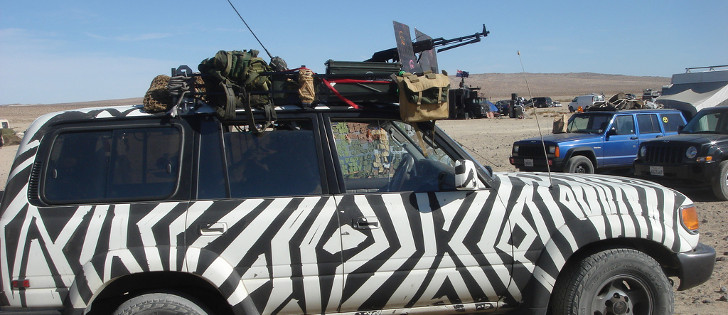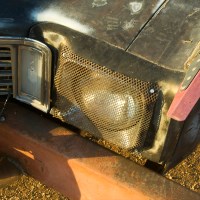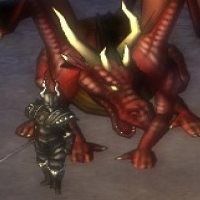Wasteland Motorized Tribes is my new video game project where I decided to do only the parts that I enjoy. Game Design is one of those parts, setting up the database and providing customized access to it are a few others. This is the game design document for the game, although it can (and probably will) change wildly over time, especially if I manage to recruit an interface designer.
(Image of the "Land Crusher" shameless stolen from the Wasteland Weekend website vehicle tips page)
As of now, I'm still looking for an interface designer to join the project as a partner in crime.
Inspiration
It seems pretty evident that Wasteland Motorized Tribes is heavily inspired by the universe of the Mad Max movie quadrilogy by George Miller, and more specifically by Mad Max: Fury Road about which I wrote a mixed review in french. I say universe because I don't care much for the actual characters, plot and events of said movie. Wasteland Motorized Tribes retains only the completely absurd but awesome at the same time principle that in a post-apocalyptical world with scarce resources, humans will organize in tribes driving around in the desert in heavily modified vehicles mostly fitted with gas-guzzling V8 engines.
Background
This is the lightest part of this document because it doesn't really matter to enjoy the game. Knowing the exact nature of the apocalypse is not required, as well as knowing the overall state of the planet Earth after said apocalypse. The only thing that matters is that every single playable tribe in this world has access to heavy metal fabrication tools like power saws, welding kits, steel mills in order to create their vehicle from recovered scraps.
Game elements
Resources
There are three main resources available in the Wasteland : Water, Gas and Scrap Metal. Each one has a different impact on how the player's tribes will look and act.
Water
Water is necessary to sustain organic life, and as such will be used by the tribe's members on a regular basis. More available water means more tribe members. It can be commonly found in the desert in small quantities, but large supplies are rare and a reason to fight for.
Instead of a traditional upkeep system, I'm envisioning a simple system where the next tribe member would cost more water than the previous, thus eliminating the tedious need to find water on a regular basis, only to replace fallen tribe members or to grow a tribe. Tribes holding an infinite water supplies will have a large number of tribe members, but their operations will be limited by scrap metal and gas.
Gas
Gas is necessary to sustain mechanic life, and as such will be used by the tribe's vehicles operating in the desert. More available gas means a larger fleet of vehicles can roam around the desert. It can rarely be found as is in the desert, however any captured vehicle or retrieved wreckage will contain some from its fuel tank. Refineries provide formidable supplies of gas, but are rare and highly strategic, expect heavy resistance.
Gas will be used on a per-distance traveled basis. Each vehicle will be able to hold a certain amount of gas which will have to be replenished either at the camp or on the road by scavenging. Tribes holding an infinite supply of gas will be able to feature larger engines and higher operating ranges, but will be limited by scrap metal and water.
Scrap metal
Scrap metal is used to build and repair anything, from vehicle parts to weapons to buildings. More scrap metal means better and stronger vehicles and structures. It can be commonly found in small amount in the desert, but the bulk of it will come from captured vehicle and found wreckage as well as recycling old parts. Unless you get a hand on a mine, but this is no easy task if it is guarded. Scrap metal is consumed through ammunition and mechanical parts wear and tear.
This resource is consumed instantly from the available stockpile, either at a camp or in a suited vehicle, either for fabricating or repairing. Tribes holding an infinite scrap metal supply will have bigger vehicles and heavier mounted weapons, but will be limited by gas and water.
Economy principles
It should be unlikely for a single player to control two infinite supplies of two different resources, so trade will be the name of the game. However, resources don't move by themselves, and trucks convoys will have to ship various resources around the desert. This will provide hijacking opportunities to roaming players or NPC.
Tribes
A tribe is a group of survivors trying to get by in a hostile desert populated with natural disasters, marauders and rival tribes. Each tribe has its own fleet of vehicles to help them scout surroundings, scavenge for resources or trade with various partners. A tribe can set a base of operations up to store more resources and expand fabrication capabilities.
Tribe members
As soon as a tribe has enough water, it can recruit a new member into the tribe. We assume there are many nameless survivors that are waiting to be recruited by any tribe wanting to spare some water. Each tribe member can grow in skills before tragically dying either in combat or of illness.
Specialized tribe
Tribes holding infinite resources points will want to use this to their advantage, thus "coloring" their fleet according to their stronger suit. Here are a few examples of what each of the three specialized tribes could sport:
- Water tribes: Bus, water lance, boarding pole, boarding slingshot, suicide motorcycle, poisoned handheld weapon.
- Gas tribes: V10 engines, V12 engines, jet engines, flamethrower, Molotov cocktails, gyrocopter, incendiary grenades, thermobaric grenades, nitro boost
- Scrap metal tribes: Heavy armor plating, heavy chassis, caterpillar tracks, cannons, hydraulic arms, spikes, buzzsaws
Vehicles
Vehicles are modularized and can be dismantled for parts and reassembled at will. There are a few types of vehicle parts:
- Chassis : This determines the weight that the vehicle can support. Larger parts generally are heavier and need a bigger and stronger chassis. Chassis range from motorcycle to military truck.
- Engine(s) : This determines the max speed of the vehicle in relation to its total weight. More engine power, more speed. More weight, less speed.
- Fuel Tank : The size of the reservoir determines the operational range of a vehicle before needing refueling.
- Armor : Those heavy plates of metal shield critical parts of vehicle from enemy attacks, at the cost of vehicle speed.
- Weapons : Various mounted weapons to help fend off attackers or to assault enemy convoys. Use ammunition made from various resources.
- Wheels : Bigger wheels allow more clearance and off-road capabilities to traverse rough terrain.
- Cargo : Whether the vehicle is able to haul resources and how much of it.
- Special : Those parts gives various special abilities depending on the part. Most of those parts can't be fabricated and will have to be found in the desert.
Vehicles can rarely be completely destroyed. The first stage of damage is simply "disabled". One of the vehicle critical parts has been damaged and the vehicle can't continue driving. The vehicle stays in place until repaired on the spot or towed by whoever gets there first. The second stage of damage is "wrecked". Multiple parts took heavy damage but the vehicle is still holding in one piece. The vehicle won't go anywhere until someone scraps it. The third stage is "obliterated". The damage sustained is so great that the chassis breaks and metal debris are flying all around. This is a rare case, in part because few weapons can inflict that much damage, and in part because it doesn't provide much opportunity of loot for the attacker.
Combat
This is the part I'm the most open to discussion about. Once a chasing party catches up an escorted convoy, what is happening? A tactical turn-by-turn battle? An automatically resolved skirmish?
Nonetheless, here are my broad thoughts about what details should be included in the combat engine.
Vehicle weapons
I'm distinguishing two distinct ranges for weapons:
- Long range: Cannons, machine guns, harpoons, rocket and grenade launchers are in this category. The attacking and the target vehicles don't need to be close by to use those, but an aim check is performed to hit.
- Contact: Buzzsaws, spikes, hydraulic arms and flamethrower are in this category. They require the attacking vehicle and the target vehicle to be very close for enough time to use the weapon. However, they automatically hit.
I would like the combo harpoon + plough to work, although I don't know exactly to what effect. The harpoon allows to bind two vehicles together, preventing escape or movement altogether, while the plough is a powerful brake that should be able to stop most vehicle harpooned.
Boarding
Sending your men on perilous missions to hijack vehicles moving at high speed should be possible, whether by jumping from a close vehicle or a pole, or even by sling-shooting them at unsuspecting foes. Hijacking success will be determined by equipped handheld weapons and compared skill of the attackers and the vehicle crew.
NPC
Marauders
Bands of marauders will periodically spawn in the desert, and if left unchecked, will grow over time and may come to attack the player's convoys. However, given sufficient detection, they can be detected and assaulted before they become a threat for quick loot.
Merchants
Occasionally, you can cross path with travelling merchants, either on the road or when one is seeking refuge in your camp. Merchants sells unique wares in limited quantities that the player wouldn't be able to find or craft otherwise.
Crafting and Research
Most weapons and parts can be crafted provided the players knows how. Crafting blueprints can be acquired or researched by devoting tribe members to the task. More researchers means faster discoveries, but the process uses resources and parts in the process.
Crafting involves components consumed in the process, technical capabilities provided by tools, some time and may produce byproducts on top of the desired crafted item. Again, devoting more tribe members to crafting speeds up the process.







Your project seems really intersting. Many good ideas, I really like the impact of the most gathered ressource on the available techs. Yet, I have a concern on the overall dynamic of the game. How do we win ? When do we lose ? Those are pretty obvious questions and I don't find any answers to it in your GD, might be good to explain it .
.
For now, what I see is that the game offer two "ways" to play, either to camp an infinite supplies of a specific type of resources or to roam the desert to find a few of each type. Would the scarcity of the two other types of resources force the "camping player" to move ? Isn't it better, not matter what, to keep roaming ?
Could you make some diagrams of the way the systems you build work and interact with each other ? It might help us (you too) to see the dynamics and the player choices.
Fisrt thanks for taking the time to read and comment. As for the win condition, it all depends on the type of game we want to create. A single-player game may have a sort of storyline where the goal is to defeat a world-threatening boss of some kind. Let's say you know that in X time periods the villain will move a nuclear warhead from A to B and you may want to hijack it to avoid obliteration. However, the convoy is heavily guarded and you need to mount a sizable force to take on the challenge. In the meantime, you will have to fend off marauder and compete with rival gangs for available resources. This could be the rogue-like version.
Another possible route is the classic revenge plot. Some tribe leader has somehow wronged you, and you now only live for their demise. No time limit there, just linear progression, random events and eventually plot twists.
Lastly, the MMO route, where there would not be any "win" except being the largest tribe around. Super tribes may form, claim land, build stuff, blow opponents' stuff for fame and glory, much like EVE Online.
About roaming, I think having a base of operations is better than always having to haul everything constantly. More than a base doesn't seem realistic to me, as resources would have to be stretched too much to defend two or more easy immobile targets. The ideal would then be having a fortified camp and launch raids from it, either scavenge hunt or hijack runs. One can even imagine camp sieges, but in the case of a success the player would have to choose between either base to move back to.
About the diagram, I'm not against it, but I'm not sure what are are the "systems" you are referring to.
Added crafting.